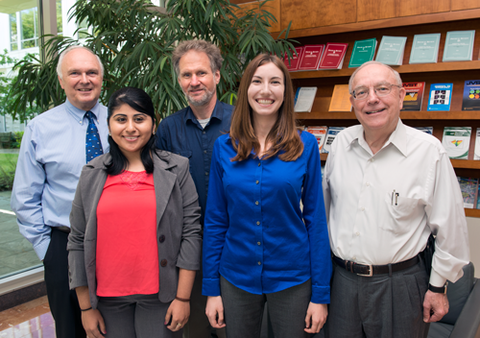
Front row: SPS interns Veronica Martinez-Vargas (left) and Teresa Turmanian. Back row: Robert Brown (left), CEO of the American Institute of Physics (AIP), which administers SPS; John Suehle (center), the students’ mentor at NIST; and David Seiler, chief of NIST PML’s Engineering Physics Division.
It's not every day that undergraduate students contribute in a meaningful way to research at a national lab in the span of a few weeks. But that's what happened to Veronica Martinez-Vargas of Salisbury University in Maryland and Teresa Turmanian of Juniata College in Pennsylvania, when they spent two and a half months working in PML's Engineering Physics Division this summer.
The two upper-division physics majors were participating in the Society of Physics Students (SPS) internship program, which places undergraduate physics students in science research, policy, and outreach positions in the greater DC area. NIST has been involved with this program since 2002.
Under the guidance of PML electrical engineer John Suehle, the young scientists helped to build a prototype for a new solid-state biomolecule sensor – a device which, when complete, should be able to identify molecules in complex solutions such as blood serum or crude oil faster, cheaper, and with greater sensitivity than the leading approaches used now. With such a tool, doctors might one day be able to give their patients a "fingerprint" of their health from a blood test within a single office visit, Suehle says.
The clinical applications of the device, along with the internship experience, have already affected at least one of the students' ambitions.
"I had an interest in medicine before this internship, but I didn't know how to tie it in with physics," says Martinez-Vargas, who moved to the United States from Mexico at 10 years old and is an active advocate for access to education for immigrants. "I'm already looking into biophysics programs for a Ph.D. so I can continue to do this type of research."
Though they were only at NIST for a few weeks, Turmanian and Martinez-Vargas successfully completed their task: affixing a layer of molybdenum disulfide (MoS2) flakes, just a few atoms thick, onto a silicon substrate for use in the electronic part of the sensor. But to do it, they had to do more than follow directions. They did real science.
The new instrument under development at NIST will operate by a totally new method for this kind of measurement. Today's biomolecule identification systems typically rely on ionic current fluctuations: a molecule is stripped of some of its electrons, and a sensor in the solution measures these ionic current fluctuations to infer a molecule's presence.
In contrast, the prototype being built by Suehle's team is a solid-state device, a metal-oxide-semiconductor field-effect transistor (MOSFET) that will measure not ionic current but much faster electronic current. In addition to the standard parts of a MOSFET, key features of the device include a semiconductor layer made of a single flake of molybdenum disulfide (MoS2) and a tiny glass pore just 7 nanometers (billionths of a meter) in diameter that intersects the transistor's active area.
When the device is in use, a molecule will enter the glass nanopore, and its unique electrostatic profile – determined by the arrangement of the amino acids that make it up – will be processed as a unique signal by the transistor.
"Because the solid-state sensor uses electron current to sense the molecule, it will be orders of magnitude faster and have a much higher signal-to-noise ratio than the ionic current approach," Suehle explains. "This should make it much more sensitive and selective."
To create the electronic part of the sensor, the interns had to prepare MoS2 flakes of the correct size and thickness by transferring them from one surface to another: first from special sticky tape to a "dummy substrate," a sort of staging ground; then on to a slab of the jelly-like polymer polydimethylsiloxane (PDMS, a type of silicone); and finally to the real substrate that would be used in the prototype.
Some steps required the students to suit up with lab coat, gloves, and goggles to chemically clean the substrate surfaces, a process Turmanian said made her feel like a "nanoscale scullery maid." They also learned how to use an atomic force microscope to assess whether their flakes were the appropriate thickness. Though the interns were familiar with some of these tasks from their university coursework, much of the experience was new.
"I was surprised at how much of this research is dependent on steady hands and keeping track of which cables go into which ports," Turmanian says.
But although they carefully followed directions, one part of the process did not go as planned: they could not get the MoS2 flakes (coated with a liquid polymer called PLLA) to stick to the rubbery PDMS. In attempt after attempt, the MoS2 remained stubbornly affixed to the dummy substrate.
With Suehle's blessing, the interns decided to systematically alter the conditions of the transfer. Their instructions had required that before transferring the flakes from the dummy substrate to the slab of PDMS, they first clean the dummy substrate's surface. In one iteration, they decided to forego this cleaning stage. To their surprise and that of their mentors, it worked.
"Intelligent disobedience for the win!" Turmanian wrote triumphantly in her blog that week.
Though the students have returned to their respective universities, Suehle's team is using the electronic device they created this summer for the next stage of construction: affixing the transistor to the glass nanopore that will accept the molecules themselves.
For his part, Suehle says he "thoroughly enjoyed" working with this year's SPS interns.
"Their desire to learn new things and their enthusiasm for the project was remarkable," Suehle says. "NIST is a special place and has a real opportunity to positively influence students like Teresa and Veronica to excel in their physics and science careers."
-- Reported and written by Jennifer Lauren Lee

